
New gun policies create controversy
A proposal in Washington to lift a loaded firearms ban in the country’s national parks is creating quite a stir this year.
While the National Park Service itself seems to not be taking a position and just letting it all play out, that has not stopped many others in the nation’s capitol from taking positions.
“We are not currently taking a position on this issue,” said Nancy Gray, who is a park ranger and spokesperson for Great Smoky Mountains National Park. “Since this is a public issue, we have decided to let it play out and see what happens in a public forum.”
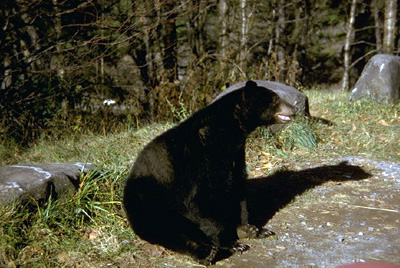 |
A black bear at Great Smoky Mountains National Park (Photo courtesy of the National Park Service). |
A majority of U.S. Senate members wrote to U.S. Secretary of the Interior Dick Kempthorne, who oversees the National Park Service, strongly urging that the current regulations be modified. Under the current rules in place, it is legal to bring a firearm into a national park as long as the gun is not loaded and is put in a not-so-easy to reach area, such as the trunk of a vehicle.
These senators seek to allow for guns to be loaded and to be carried at all times inside the boundaries of national parks and refuges. The proposal is a new draft regulation that was released on April 30 by the secretary and brought to the public for a two-month comment period. At the same time, both houses of Congress have introduced legislation about this issue.
The issue has drawn the ire of several organizations including the National Parks Conservation Association, which has raised this issue on its website and has talked about detrimental effects this proposal could have on the national parks such as endangering the native animals.
“The guns that exist in any location the risk is increased and I think there is some potential in the increased risk of wildlife although if its handguns its more likely not to be poaching, but more likely to be what we call impulse shooting,” said Bill Wade, chair of the Executive Council for the Coalition of National Park Service Retirees. “This is when somebody gets startled by a bear in a campground or even on a trail and they’re likely to shoot at it and it increases the risk to the animal itself as well as the risk to visitors.”
| The Great Smoky Mountains National Park in Tennessee and North Carolina (Photo courtesy of the National Park Service). |
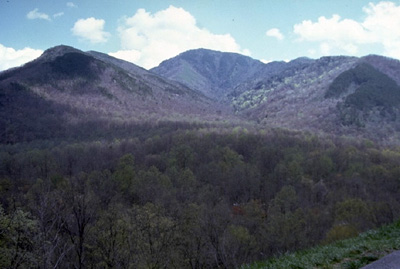 |
Poaching is also a problem in the national parks. Internationally, the gall bladders, paws, and claws of black bears can make for a very lucrative payday that provides the incentive to engage in this kind of activity. But the Coalition of National Park Service Retirees feels more strongly about the impact of impulse shooting.
“If somebody sees this bear walking by and pulls out his pistol and fires away, one of two things is going to happen– they’re either going to hit the bear or coyote or whatever it is and it’s very unlikely the animal will be killed with a handgun so a wounded animal is more dangerous than one that’s not,” said Wade. “If they miss the animal, then that bullet would keep going and possibly go into someone else’s tent and possibly wound or kill another person. Those are the kinds of impulse concerns that we worry about.”
There is more than one issue though with these proposed regulations according to these groups who oppose them.
“We think there’s going to be a lot of confusion on the part of visitors as to what the authorizations are because of the way this proposed regulation is written and needs to be consistent with whatever the applicable state law is relative to state public land,” said Wade. “The confusion can come when people travel from state to state.”
Numerous national parks and other units are in more than one state. Examples are Yellowstone National Park, which includes parts of Montana, Idaho, and Wyoming, as well as Death Valley National Park, which includes California and Nevada. The Great Smoky Mountains National Park is located in the hills of both Tennessee and North Carolina.
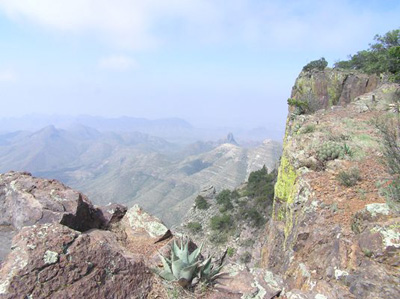 |
The Great Smoky Mountains National Park is located in both Tennessee and North Carolina (Photo courtesy of the National Park Service). |
“Requirements change. There are some national parks that are in several states so even in one national park, such as Great Smoky Mountains National Park, you can travel from North Carolina to Tennessee and you would encounter different regulations with those states within one national park,” said Wade. “I think overall its going to be very confusing for visitors and there would be some administrative requirements that would increase the complexity of where people can carry guns in administrative areas.”
States do have different firearms regulations and laws and it can get very confusing, which is why there are websites such as one managed by the National Rifle Association that help individuals understand the laws. North Carolina and Tennessee do have different laws. Just to name one difference, in North Carolina, the legal age to apply for a concealed weapons permit is 21 years of age and Tennessee’s minimum age is 18.
| Differences in state gun laws can be significant (Photo courtesy of handgunlaw.us). |
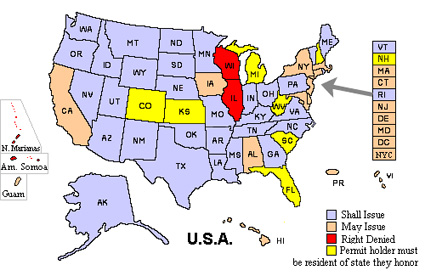 |
“The restrictions are very lax in some states and then there are others that are stringent and so as people visit or travel to another state or from one state or another not only do they get confused, but what if you have a license from one state and you travel to another state?” said Wade. “Does that state have reciprocity with the state in which you have the license or not? So visitors and rangers are going to be confronted with a lot of these issues.”
There are also some groups that are for these proposed regulations, including the National Rifle Association, which has publicly supported these regulations for a while now. The NRA was contacted several times but did not return calls.
However, the NRA has previously said that the organization has been trying to get these procedures moving as many as five years ago. The NRA also voiced its opinion in a recent press release saying that “the NRA believes that it is time to amend those regulations to reflect the changed legal situation with respect to state laws on carrying firearms.”
To support this claim, according to the NRA website, “only six states routinely allowed citizens to carry handguns for self-defense” when the original regulations were put in place in late 1982 and now “currently 48 states have a process for issuance of licenses or permits to allow citizens to carry handguns for self-defense.”
As what usually is the case with politics in Washington, this issue surely will not be resolved overnight.
“It could go on for quite a while,” said Wade. “It will either be extended into the new administration and/or it will end up in court. It’s not something that’s going to sail through easily one way or another.”
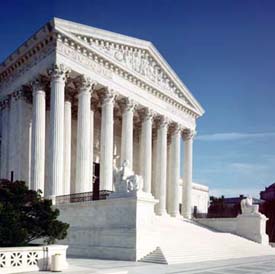 |
Some experts feel that the issue of gun use in the national parks may not go away easily and could possibly end up before the U.S. Supreme Court in Washington, D.C. (Photo courtesy of supremecourtus.gov). |

Comments are Closed